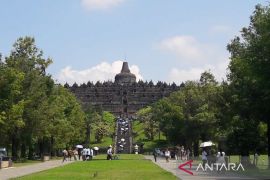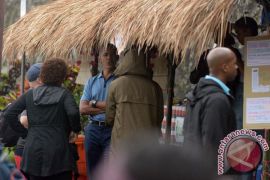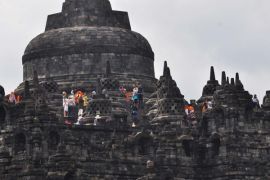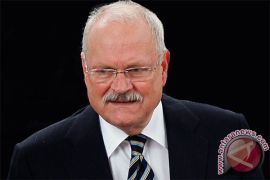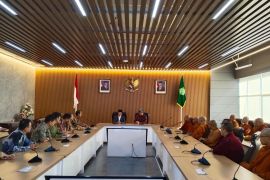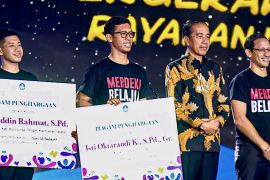On September 16, the state-run management of the temple PT TWC began a trial on the new area to identify areas for improvement to serve visitors better and get people accustomed to the changes made.
After several decades, the reconfiguration of the Borobudur Temple complex is finally completed under the administration of President Joko Widodo (Jokowi).
On September 20, Jokowi signed Presidential Regulation No. 101 of 2024 concerning the governance of the Borobudur Temple complex.
Essentially, the complex overhaul is meant to boost tourist numbers and bring economic benefits to local residents while ensuring the temple's sustainability.
As the new hub of the temple compound, the Borobudur Art Village, covering 10.74 hectares of land, can accommodate 1,943 vendors, 414 motorbikes, 368 cars, and 96 buses.
In addition to a museum dedicated to displaying the history of the ancient gigantic temple, the brand-new village also has pavilions, ticket counters, an amphitheater, culinary kiosks, and a merchant zone.
The village, to be inaugurated by President Jokowi in early October, is designated as the entrance to Borobudur, which has been declared a UNESCO World Heritage Site and stands as the world’s largest Buddhist temple.
Coordinating Minister for Maritime Affairs and Investment Luhut Binsar Pandjaitan has forecast that once the development of the Semarang-Yogyakarta Toll Road concludes, Borobudur Temple's annual visitor count might rise to around two million.
“We can expect to rake in two million tourists, including from Thailand, Japan, and China, seeking to embark on a journey here,” he remarked, as cited from his ministry’s statement.
Pandjaitan also spoke of having urged the Acting Head of Magelang District, Sepyo Achanto, to erect homestays and prepare local people to yield higher profits, as he believes that the tourists might stay for five to 10 days in the region.
The minister explained that preparing, educating, and mentoring local residents would lead to the emergence of new micro, small, and medium enterprises (MSMEs) and intensify the holding of artistic events.
In his view, it is also crucial to ensure the appropriateness of the regional spatial planning (RTRW) and that all structures around Borobudur embrace the Javanese style or display the characteristics and image of the temple itself.
“This is important to preserve our culture here,” he stressed.
Enticing Buddhist visitors
Maya Watono, Marketing and Tourism Programs Director of InJourney, the parent company of PT TWC, highlighted that Borobudur Temple has immense potential to help develop Indonesia’s cultural and spiritual tourism appeal.
She assessed that the temple is of high value in the eyes of around 450 million Buddhists worldwide, 64 million of whom reside in fellow Southeast Asian country, Thailand.
“Say that we attract at least three percent of the total 64 million potential tourists from Thailand to the Borobudur Temple, we will be able to bring considerable economic benefits to Magelang and Central Java,” she noted in her company's statement.
In the hopes of boosting Borobudur's connectivity for Thai travelers, InJourney and Thai Airways signed a memorandum of understanding (MoU) on August 19 to open direct flights from Bangkok, Thailand, to Yogyakarta International Airport, which is closest to the temple.
“The annual tourist count of Borobudur Temple is 1.4 million, with foreign tourists contributing 10 percent to the figure. We are quite optimistic about the connectivity deal shooting up the number of foreign tourist visits by three to five times,” Watono stated as one of the signatories.
In the same statement, PT TWC President Director Febrina Intan spotlighted the need for synergy and collaboration among relevant stakeholders, including the Central Java provincial government, Magelang district government, and local communities, to allow the tourism ecosystem around the temple to grow.
She also said her side had initially held a dialogue with merchants operating around Borobudur before proceeding with the relocation plan. Most of them understood that relocation to a more proper space was necessary to offer visitors more memorable experiences.
The Borobudur Temple complex has now become greener following the relocation of vendors.
PT TWC also offers MSMEs training activities to ensure that the Borobudur Art Village's presence can improve the locals' economic and social conditions.
Moreover, during the trial period, which will conclude by the end of the year, the temple’s management will provide free electric vehicle services to pick up and transport visitors from the art village to the temple and vice versa.
“We might dispatch additional electric vehicles in the event of a hike in visitors during school holidays. As for now, we are operating 15 electric vehicles, with a capacity of 23 passengers each,” Intan remarked.
Without vehicles, visitors can reach Borobudur Temple from the art village on foot through an approximate one-thousand-meter route lined with trees along the way.
Related news: Minister Uno declares Wanurejo best tourism village
Related news: President Jokowi spends weekend with family at Borobudur Temple
Translator: Heru Suyitno, Tegar Nurfitra
Editor: Azis Kurmala
Copyright © ANTARA 2024

